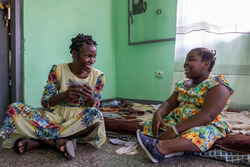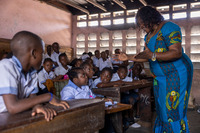Daïsane, 10, lives in Lemba, a district of Kinshasa, in the Democratic Republic of Congo. Daïsane was born with club feet, a congenital malformation of the lower limbs, which makes it almost impossible for her to walk. Daïsane had several unsuccessful operations before she met HI in 2021. At school, she was given a wheeled chair with a small writing table and a footrest to support her ankles, and later provided with a wheelchair to move around at home and make the trip to school. She can now do more things on her own.
A protective and caring big sister
Daïsane’s older sister, Vasli, 27, is a law student. Until recently she worked as a negotiator on the Lemba youth council. She plays an active role in her community and is very curious about how things are organized in Europe. One day, she would like to be lucky enough to travel and find out how other countries work.
Vasli tells us how, before she received her wheelchair, Daïsane used to move around by using her hands to drag herself along the floor. For obvious reasons, this severely limited her mobility.
“When she got her wheelchair a few weeks ago, she was grinning from ear to ear - her face lit up!”
 At last, Daïsane can finally move around by herself in the courtyard in front of her home, on the road to school or on the playground! It’s easier and faster than before, which is a real source of satisfaction for the whole family. She can now live in dignity.
At last, Daïsane can finally move around by herself in the courtyard in front of her home, on the road to school or on the playground! It’s easier and faster than before, which is a real source of satisfaction for the whole family. She can now live in dignity.
Although Daïsane loves to play cards with her sister, her real passion is drawing – especially different kinds of clothes. In fact, her mind’s already made up: she’s going to be a fashion designer one day!
“Before, we paid for a motorcycle taxi to take Daïsane to school. It was quite expensive, but now she can go in her wheelchair. It takes us about an hour each way, but it saves money. Daïsane is only ten, so we prefer to go with her to school,” explains Vasli.
Adapting to free education in Lemba inclusive school
 Once Daïsane arrives at school, the concrete pavements laid by HI make it is easier for her to get to class. As part of its support to this inclusive school, HI has equipped the classrooms with wider and lower boards so everyone can use them. The teachers have also been trained to tutor students with special needs.
Once Daïsane arrives at school, the concrete pavements laid by HI make it is easier for her to get to class. As part of its support to this inclusive school, HI has equipped the classrooms with wider and lower boards so everyone can use them. The teachers have also been trained to tutor students with special needs.
In 2019, the Democratic Republic of Congo made education free for all. Previously, parents had to pay to enroll their children in school and schools used this money to pay their teachers. Now, in most state schools, teachers’ wages are funded by the government and are directly responsible for their facilities. A school administrator shared some of the problems that have arisen since the new system came into effect.
“Two years ago we had about 600 students. Since the start of free education, student numbers have risen to about 1,100. No one was expecting such a big rise. Sometimes teachers have more than 60 students in their class! It’s very challenging.”
Lemba school receives around $35 USD a month for maintenance, supplies and equipment — a very small amount to cover all its requirements, especially since more young students now attend the school.
Everyone, both students and teachers, has had to adapt to these somewhat unusual circumstances. Despite the larger class sizes, “Mrs. Agnès” says Daïsane has made good progress, thanks in particular to her small, specially adapted table and wheelchair.
“The wheelchair means she can leave the classroom and play outside. She doesn’t have to stay inside by herself like she did before.”
Mrs. Agnès enthusiastically describes how she makes sure Daïsane is fully included in lessons and puts her in the front row at the start of each class. She also helps her move from her wheelchair to a small, specially adapted table. This means Daïsane can write and follow the lesson without having to make an extra effort. And her favourite subject? Math!
Daïsane is now fully engaged in class and plays with her friends at breaktime. She feels part of the school and can move around on her own – with dignity.



 At last, Daïsane can finally move around by herself in the courtyard in front of her home, on the road to school or on the playground! It’s easier and faster than before, which is a real source of satisfaction for the whole family. She can now live in dignity.
At last, Daïsane can finally move around by herself in the courtyard in front of her home, on the road to school or on the playground! It’s easier and faster than before, which is a real source of satisfaction for the whole family. She can now live in dignity. Once Daïsane arrives at school, the concrete pavements laid by HI make it is easier for her to get to class. As part of its support to this inclusive school, HI has equipped the classrooms with wider and lower boards so everyone can use them. The teachers have also been trained to tutor students with special needs.
Once Daïsane arrives at school, the concrete pavements laid by HI make it is easier for her to get to class. As part of its support to this inclusive school, HI has equipped the classrooms with wider and lower boards so everyone can use them. The teachers have also been trained to tutor students with special needs.
